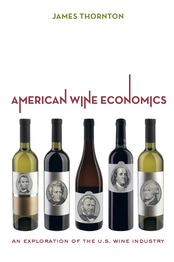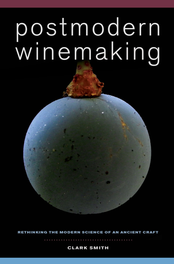Wine drinkers and collectors with an interest in the economics of American wine–and the techniques of winemaking in a post modern age–may take interest in two texts released in late 2013 by the University of California Press. U of C Press is a prolific publisher of wine books geared both for the consumer as well as the trade and academia. It is worth noting, however, that both of these new texts are geared more for the wine professional.
Exploring the Economics of Wine
James Thornton, professor of economics at Eastern Michigan University, is the author of “American Wine Economics,” a 307-page exploration of the U.S. Wine Industry…from an economic perspective. According to Thornton, the text is “intended for students of economics, wine professionals and general readers who seek to gain a unified and systematic understanding of the economic organization of the wine trade.” Make no mistake: Unless you  are a student of economics and/or a wine professional, the academic bent of this dense text may leave you, the general reader, looking for a book that pulls a smile now and then.
are a student of economics and/or a wine professional, the academic bent of this dense text may leave you, the general reader, looking for a book that pulls a smile now and then.
Following an Introduction, the author sets off with “The Economic Approach to the Study of Wine,” wherein he explains “the important ideas” of scarcity, choice, opportunity cost, rational self-interest and economics incentives. Opportunity cost simply means, “Whenever a choice is made, a cost is incurred,” a reality that might be applied to everything we do in life. Explaining “rational self-interest” is a bit more involved, but Thornton offers this: “The assumption of rational self-interest implies that wine consumers choose the combination of wine products and other goods and services that maximize their utility, given their money and time resources, which limit their available alternatives.” Did you struggle with econ when you were in college?
The remaining twelve chapters cover a range of topics such as “Grape Markets and Supply Cycles,” “Wine-Firm Behavior “and “The Globalization of Wine.” The chapter on globalization of wine is an examination of how wine has transcended national borders and markets to become a global product, with the author citing such international wine icons as Germany’s Blue Nun (annual sales of 500,000 cases in more than 100 countries) and Australia’s Yellow Tail, selling 10 million cases of wine annually in 20 countries. And then there’s Blossom Hill, a truly multi-national wine. According to Thornton, Blossom Hill is “produced in California, bottled in Italy and sold primarily in European countries by the London-based conglomerate Diageo.”
Thornton adds a bonus with chapters on “Wine Sensory Characteristics” and “Grape Growing.” His reasoning is that “wine professionals” who are supposed to know about the smell and taste of wine are germane to wine economics because they make economic decisions in the wine market. Thornton credits most of the information contained in these two sections to known wine writers like Jancis Robinson, Mary Ewing-Mulligan and Ed McCarthy. He also includes a handful of illustrations and an equal number of tables, the latter showing wine consumption and sales stats for 2010, the latest year, not exactly the most current data for economists to work with.
Winemaking in the Modern Age
As a craft, wine writing is mostly as serious as a heart attack. Occasionally, though, a little humor creeps in, such as in Clark Smith’s “Postmodern Winemaking: Rethinking the Modern Science of an Ancient Craft.” Smith, a California winemaker who has rattled more than a few cages with his theories on wine chemistry and its applications to modern winemaking, takes a serious stab–sometimes with his tongue planted firmly in his cheek–at the many ins and outs of modern winemaking in this 302-page expanded treatise. His chapter and section titles lighten things up a little with humorous (sometimes irreverent) section titles. The book is divided into four parts: Principles, Practices, Technology, Philosophy, with such provocative  sub sections as, “Winemaking’s Lunatic Heroes,” “Some Like it Hot,” “Natural Wine Nonsense,” and “Harmony and Astringency: Nice and Rough.”
sub sections as, “Winemaking’s Lunatic Heroes,” “Some Like it Hot,” “Natural Wine Nonsense,” and “Harmony and Astringency: Nice and Rough.”
One especially entertaining chapter addresses the eccentric winemaker that is Randall Grahm. Smith, who sees Grahm as “a kind of periscope for looking into the future,” is not sure if he is a wine visionary or a false prophet. Here’s what Smith wrote under the sub-chapter heading “The Bullshit Meter”: “The life of Randall Grahm is a living inquiry into the relationship of the artist to his audience. Frankly, I am suspicious whether his positions originate in well-considered values or merely from what sounds good, in an effort to surf the wave of public approval.” Smith is not the first person to voice a suspicion about what some observers call RG’s shtick.
But there’s a more, plenty more, and a good chunk of the book deals with serious winemaking questions and concerns. Smith builds his premise throughout the four parts; the first two parts are the set up with observations on oak, oxygen and wine, Randall Grahm, grape grower Bob Wample and a group of wine folks to whom Smith snarkily refers as “Winemaking’s Lunatic Heroes,” a diverse group that includes Martin Ray, Konstantin Frank, Sean Thackrey and Christian Mouiex, who Smith calls a “militant Luddite.” In the second two parts, the author expounds on such hot-button topics as biodynamics, natural wine, and methods of filtration.
“Postmodern Winemaking” is a well-written, highly opinionated and at times irreverently fun read, even for the non-technical wine lover. Pour yourself a glass of Randall Grahm’s Bonny Doon wine (any one), settle back in a chair made from old barrel staves and see if you agree.
American Wine Economics, James Thornton, University of California Press, hardcover, $39.95, ISBN: 520-27649-3
Postmodern Winemaking, Clark Smith, University of California Press, hardcover, $34.95, ISBN: 978-0-520-27519-5
* * *
Gerald Boyd is Columnist Emeritus for Wine Review Online, contributing book reviews regularly in this space from his so-called “retirement.”
6
